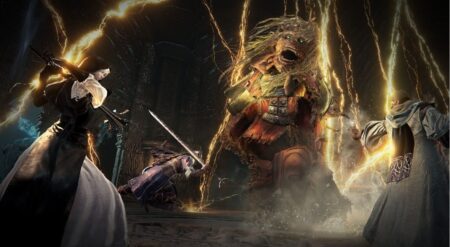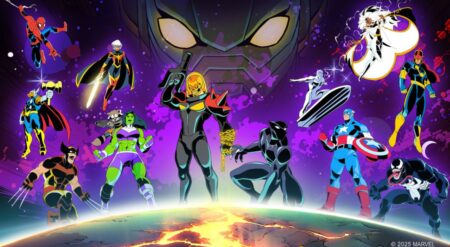FBC Firebreak, developed and published by Remedy Entertainment, is a PvE multiplayer FPS. Players are tasked with taking on missions to counter the threat of supernatural phenomena that pose a danger to The Oldest House. Armed with makeshift equipment and a generous helping of “can-do,” players must defeat hordes of enemies and tackle tricky situations to keep their paranormal institution from being destroyed.
The core FPS mechanics players use to survive their harrowing missions provide a solid foundation for FBC Firebreak. Standard weapon choices like pistols, shotguns, and automatic weapons offer the bulk of the FBC team’s offensive power. Along with these tried and true weapons, each player is equipped with a more original piece of gear at the game’s start.
These secondary pieces of equipment are the highlight of FBC Firebreak‘s gameplay. Providing different elements to each class, these tools give players things to do that don’t directly relate to killing enemies. The water ejector, for example, is used to dose fires and remove several status effects from characters. An electric implement lets its user charge particular objects, giving players more options as they carry out their tasks. The two can also be combined to produce shocking results.
This balance of offensive weapons and utility equipment helps keep the gameplay from becoming too one-dimensional in FBC Firebreak. Juggling firing at enemies and keeping teammates clean of a threatening effect or activating a device gives the game a moment-to-moment energy that pushes decision-making when a horde of enemies is approaching.
Combat is incredibly basic in FBC Firebreak.

Dealing with other tasks while fighting off enemies is important. There are only a handful of enemy types in the game, and they almost all appear in every mission in FBC Firebreak, and only a couple of those require any particular tactics to overcome. This simplicity prevents the combat from being fully engaging. Rather, it provides only the briefest moments of intensity when enemy numbers are swelling and many more forgettable moments of shooting gallery-style combat.
Another tool that players have to help them survive is their shield. This defensive element provides the protection you’d expect, but recharging it has a twist. Shields recharge when you are near an ally. This proximity charging encourages players to stick together, or at the very least, form up when a situation starts looking dicey.
Along with enemies and environmental hazards, players must spend a fair amount of time “fixing” equipment. While these mechanisms cover a wide range of contraptions, the mini game to bring them online is the same, and it’s pretty ingenious.
The visuals in the minigames are fantastic.

When the mini-game begins, a cascade of symbols denoting a pair of buttons (LB and RB on my Xbox controller) appears that must be pressed in the order presented until a threshold is met. Behind the cascade, the character’s hands will slap and fiddle with whatever device they are trying to get working.
The frustrated energy of the onscreen actions is a wonderful dose of color in FBC Firebreak. It elevates a simple system by excellently translating what the button presses represent. This also helps play into the need for speed, as time can be of the essence, and the onscreen frantic presentation can mirror player feelings. However, these fun, colorful moments are often lost in the larger mission structure.
At launch, FBC Firebreak will require players to overcome one of five unique missions. With each successful run, each mission expands, unlocking three tiers of assignments for each one. This is a clear attempt to give the limited mission selection some added depth. Unfortunately, it’s not particularly successful.
Some levels use the expanding mission structure well. For example, the mission Hot Fix gives players an evolving scenario to play through. Within each assignment phase, the group is tasked with a different objective that creates a sensible narrative. Others, however, just give the players the same task repeatedly. Creating a sizable level of tedium in several of the missions.
Having to do mission elements for too long is the greatest weakness that plagues FBC Firebreak.

Every task just takes too much time. Even when a mission is mixing up the objectives, the number of times the new goal is done feels exhausting by the end. And through every step of the way, players contend with the same small group of enemies who dog their steps.
Once players unlock the third tier of a mission, they can introduce corruption into a mission. The central element of corruption is the possibility of anomalies appearing. These random occurrences bring special modifiers to matches, such as depleting shields or making enemies faster. Players must acquire a special gun from the environment to remove the modifier and destroy a possessed object. These can range from floating hammers to stop lights, sometimes creating surreal moments.
These modifiers can change missions to an extent, but never felt like a true refresher for the quickly familiar feeling objectives. Due to the passive nature of all the ones I saw, it just made some matches feel more difficult without changing the game in a striking way. This inability to meaningfully impact the game with modifiers also shows up in FBC Firebreak‘s skill system.
As players complete missions in FBC Firebreak, they will come across asset folders. These folders award asset points players can use to unlock equipment, passive skills, and cosmetics. Equipment and cosmetics can be unlocked via the requisitions screen, while skills are gained through research, though all share the same currency.
The equipment and cosmetic acquisition setup is simply bad.

Separated into groups, players must clear one group of items before unlocking the ability to purchase ones from the next. This is nothing but frustrating. It would be bad enough if you were required to spend hard-earned points on weapons you aren’t likely to use, but having to buy sprays and helmets before you can upgrade your favorite weapon is infuriating. In one case, the sub-machine gun is four groups in. This means it could take several hours to unlock the first upgrade for a default weapon, assuming you don’t spend any of your points on skills.
The player must even wade through this situation to unlock two of each class’ abilities. Happily, you don’t have to go too far to reach these elements, but not having them available right off the bat is annoying. Locking them within this system feels like an artificial attempt to extend the game’s variety, with little payoff. Skills are better structured, but they have their struggles.
Initially able to equip a single skill, players unlock additional slots to provide more varied builds as they progress. There is a wide range of skills to pick from, with most able to impact the gameplay meaningfully. The problem is that they are not interesting or exciting.
Skills offer largely “under-the-hood” bonuses. Do a thing faster, carry more of a resource, or do more damage with specific attacks, etc. There are even team-focused ones to help the group as a whole, and not just the individual. However, due to the passive nature of these skills, their help is felt but not in an engaging way.
The visual style of FBC Firebreak is forgettable.

This deprives the skill suite of any excitement. It doesn’t encourage further play even when a handy skill is unlocked. There is never a moment when you want to dive back into another mission to try out the skill you just earned.
Each mission zone feels drab and lacks any real variety or striking element. Areas like a colossal blast furnace feel like they should stick with you, but fail to leave a lasting impression. This blandness is also true for enemy designs. We’ve all seen undead hordes charge us, and these numberless minions do little to stand out. While they may hover in the air in their office chairs or have a whole other person growing out of their back, nothing about the enemies manages to approach striking or memorable.
FBC Firebreak tries to create a novelness with the player character’s look, and kind of succeeds. The makeshift armor and weapons worn are interesting and bring a bit of personality to the game; however, as this is an FPS game, that is the least helpful place to have creative design, as you rarely see your character.
As FBC Firebreak is a multiplayer game, you may wonder if you need a dedicated group of friends to play the game. The answer is no, though it surely helps. Missions can be attempted single-player, but I wouldn’t recommend this path. Even when you are winning, there is little fun to be had.
Playing FBC Firebreak with random players off comms is fine.

It can take a bit longer to struggle through fights without the added coordination, but as long as everyone knows what they are doing, you should be able to succeed. But playing with chat up and everyone knowing what each other is doing is easily the best way to navigate a mission.
For those interested in what lies beyond the day one launch, Remedy has said they are planning to make sizable updates for this year. Targeting fall and winter, respectively, these promise to bring each a new mission, enemies, equipment, and other content for free, as well as some premium cosmetics.
FBC Firebreak delivers an experience that is, at its best, competent and, at its worst, tedious. Given the glut of options in the multiplayer FPS market and the $40 price tag this game carries, it is hard to suggest it to anyone. It’s the kind of game you could have fun playing with friends, but not because you are playing this game; rather, the game is just good enough not to hamper an otherwise good time. And that’s not nearly enough these days.
FBC Firebreak is available on PC, PlayStation 5, and Xbox Series X/S.
FBC: Firebreak
-
Rating - 5.5/105.5/10
TL;DR
FBC Firebreak delivers an experience that is, at best, competent and, at worst, tedious. Given the glut of options in the multiplayer FPS market and the $40 price tag this game carries, it is hard to suggest it to anyone.








